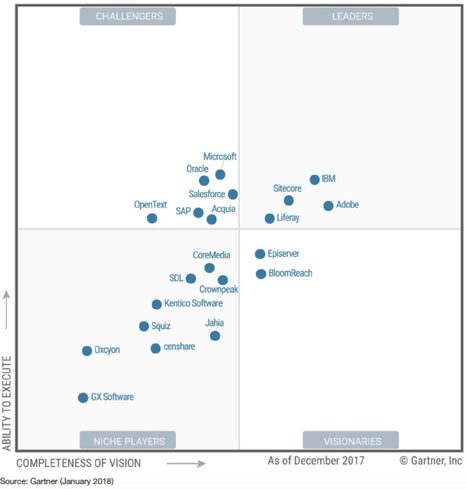A Gartner 21 digitális élményplatform (DXP) -szolgáltatót vizsgáló értékelése, jövőképük és ennek végrehajtására vonatkozó képességük tükrében.
Organizations are looking to use DXPs as they move from web-centric to more pervasive, multichannel digital experiences. This Magic Quadrant will help those responsible for a range of customer-, employee- and partner-facing initiatives find the most suitable vendor for their needs.
Gartner defines a digital experience platform (DXP) as an integrated set of technologies, based on a common platform, that provides a broad range of audiences with consistent, secure and personalized access to information and applications across many digital touchpoints. Organizations use DXPs to build, deploy and continually improve websites, portals, mobile and other digital experiences.
DXPs manage the presentation layer based on the role, security privileges and preferences of an individual. They combine and coordinate applications, including content management, search and navigation, personalization, integration and aggregation, collaboration, workflow, analytics, mobile and multichannel support, in order to:
- Provide end users, including customers, employees, partners, citizens, students and other audiences, with unified, timely and continuous access to relevant information, interactions and knowledge.
- Aggregate and coordinate disparate local and remote content, applications and web services into cohesive experiences.
- Facilitate and apply user experience design practices, such as persona modeling, journey mapping, responsive layout and data-driven design, to improve individuals' digital experiences.
Many DXP offerings derive from portal platforms, web content management (WCM) systems, or enterprise content and collaboration systems as they evolve and converge to support individualized digital experiences.



 Your new post is loading...
Your new post is loading...








Na, erről a Gartner mágikus négyzetről eddig még csak nem is hallottam, pedig nem először készült. Az előző (2016-os) óta jó sok változás történt.
A hivatkozott cikkből indulva (néhány adat megadása után) lehet megkapni a teljes anyagot. Itt egy közvetlen elérés (ha működik): https://www.gartner.com/doc/reprints?id=1-4P1DVJ8&ct=180117&st=sb
#Gartner #DXP #Liferay #Sitecore #IBM #Adobe @Gartner @Itangohu @liferay